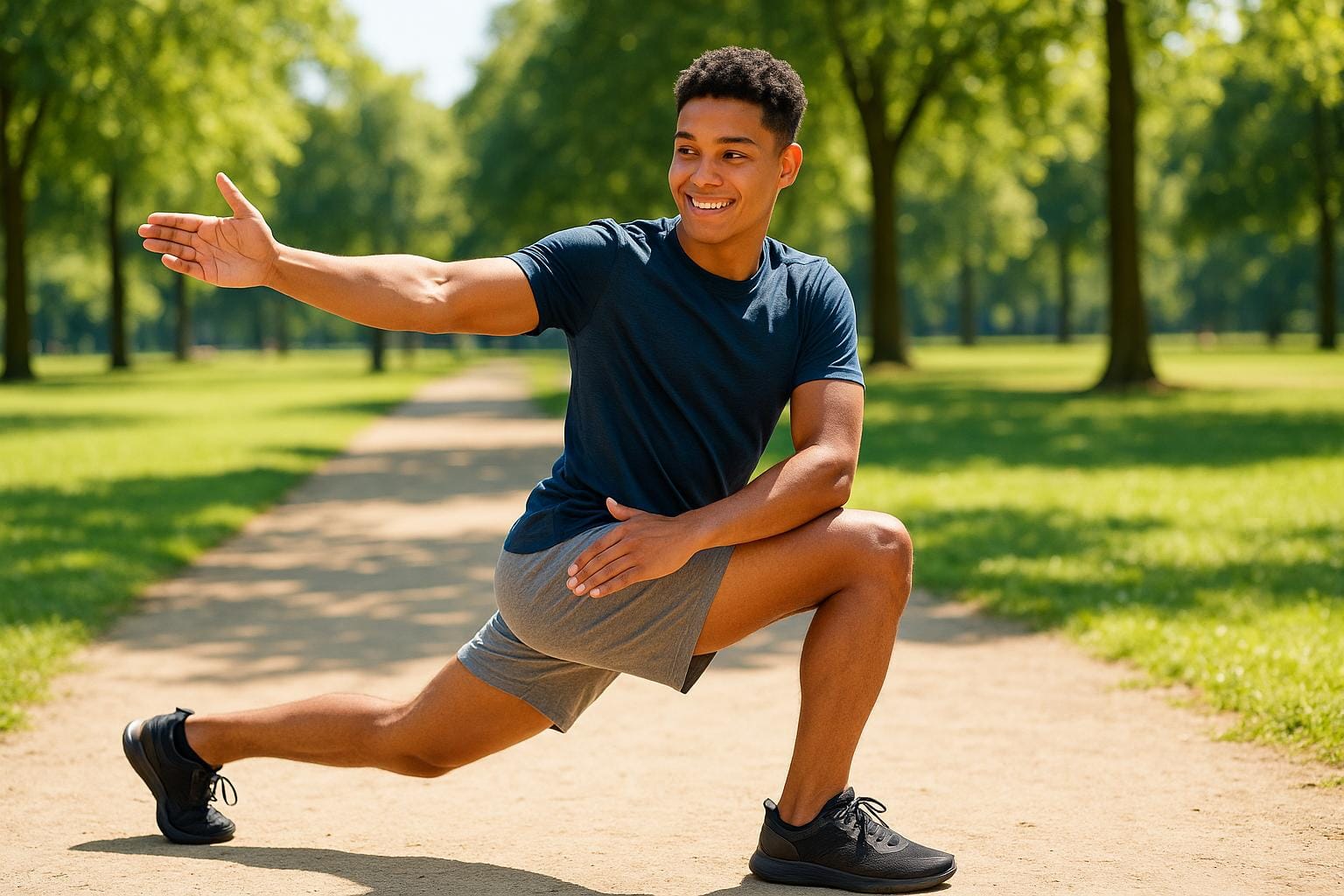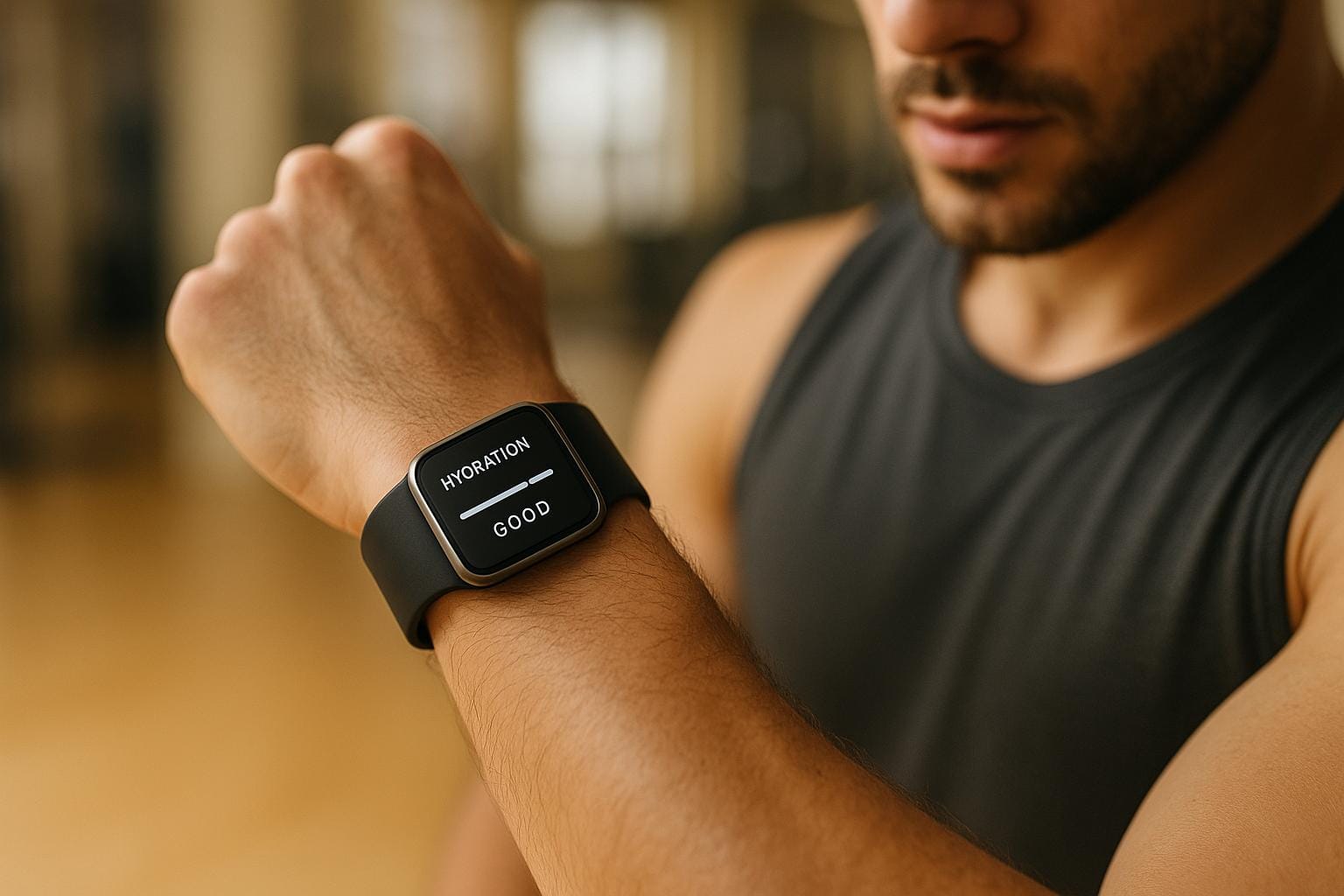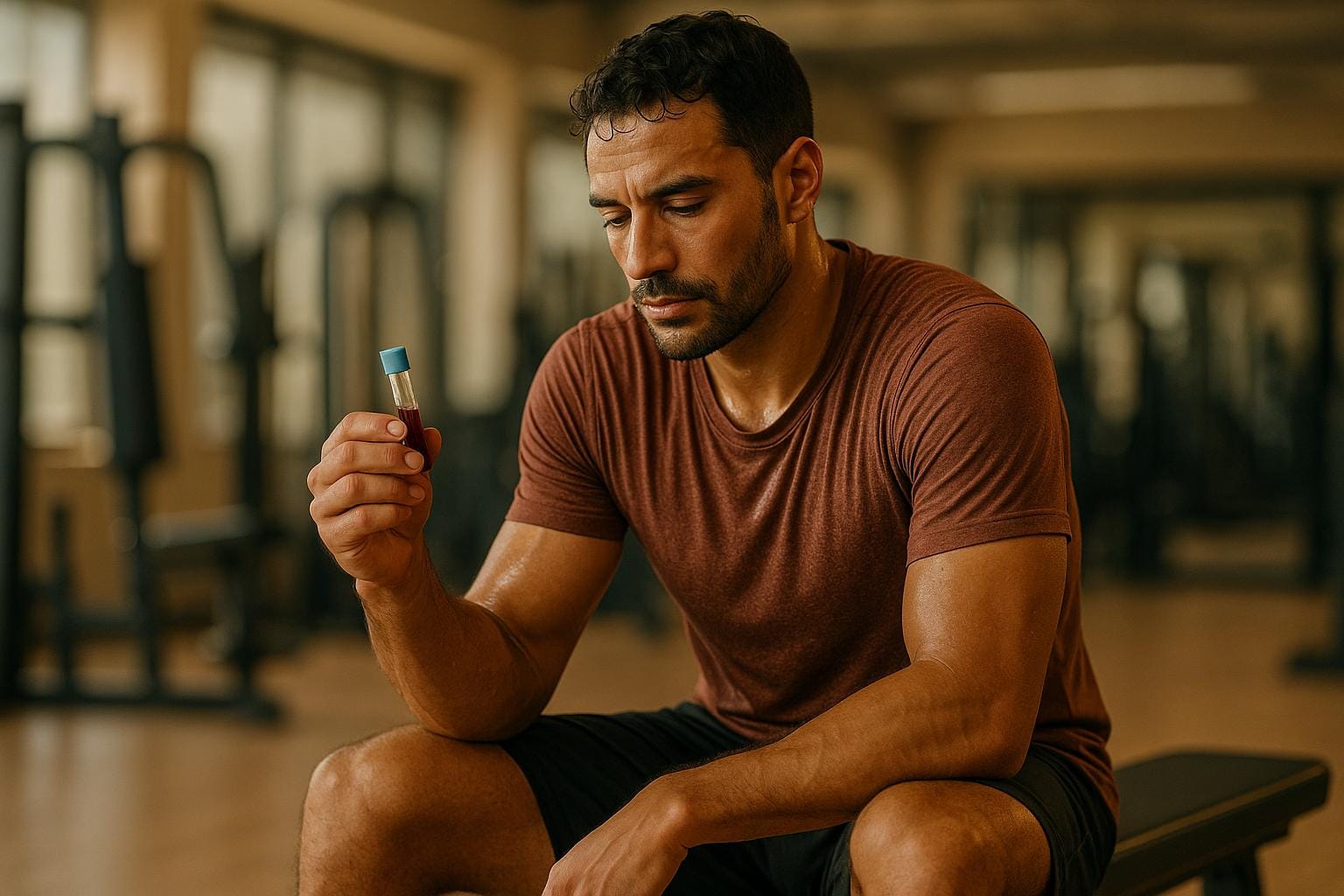Dynamic stretching is a must for beginners starting their fitness journey. It warms up your muscles, improves mobility, and reduces injury risk. Unlike static stretching, dynamic stretches involve controlled, continuous movements that prepare your body for exercise. Here’s a quick overview:
- Why It’s Important: Prepares muscles and joints, lowers injury risk, and boosts workout performance.
- Examples: Arm circles, leg swings, walking lunges, and torso twists.
- When to Use: Before workouts for better flexibility and range of motion.
Dynamic stretching is simple, effective, and essential for safe, efficient workouts. Let’s dive into how to use it in your routine.
Full Body Dynamic Stretching For Beginners // Beginner Dynamic Stretches

Understanding Dynamic Stretching
Dynamic stretching involves actively moving your muscles and joints to get your body ready for physical activity. Unlike static stretching, it focuses on continuous motion rather than holding a position.
Basic Principles
Dynamic stretching relies on controlled movements like arm circles or leg swings. These movements:
- Increase blood flow, warming up muscles and delivering oxygen and nutrients.
- Activate the muscles you'll use during your workout.
- Improve joint mobility by moving through a full range of motion.
Start with slow, controlled movements, and gradually increase the intensity as your body warms up.
Dynamic vs. Static Stretches
Understanding how dynamic and static stretches differ can help you prepare for workouts more effectively. Here's a quick comparison:
| Aspect | Dynamic Stretching | Static Stretching |
|---|---|---|
| Movement Type | Continuous, flowing movements | Holding a position for 15–30 seconds |
| Best Time to Use | Before a workout | After a workout |
| Primary Benefits | Boosts blood flow and activates muscles | Improves flexibility and aids recovery |
| Examples | Leg swings, arm circles, walking lunges | Touching toes, quad stretches |
| Duration | 5–10 minutes | 10–15 minutes |
Dynamic stretching is especially helpful for beginners. It lowers the risk of overstretching cold muscles, gets your body ready for exercise, and promotes better movement patterns.
Keep your movements controlled and intentional. If you're new to dynamic stretching, start with simple exercises and work up to more challenging ones as you get comfortable.
This article is for informational purposes only and does not replace medical advice. Always consult a healthcare professional before beginning a new fitness or wellness routine.
Why Beginners Need Dynamic Stretching
Dynamic stretching is a key step for preparing your body for safe and effective workouts. It gets your muscles and joints ready, helping to lower the risk of injury, improve performance, and support better flexibility.
Reducing Injury Risk
Dynamic stretching helps protect your body by:
- Boosting blood flow to muscles, making them more flexible
- Gradually preparing your muscles for activity
- Improving joint movement and supporting connective tissues
By focusing on movements that mimic your workout - like leg swings or walking lunges before a run - you target the specific muscles you'll be using.
Boosting Workout Performance
Warming up dynamically activates essential muscles, allowing you to:
- Move more efficiently
- Maintain proper technique
- Reach a broader range of motion
- Generate more power during exercise
Enhancing Flexibility
Dynamic stretching also plays a role in improving flexibility. Here's how it helps:
| Flexibility Element | Immediate Benefit | Long-Term Effect |
|---|---|---|
| Joint Mobility | Increased range of motion | Better joint health over time |
| Muscle Elasticity | Reduced tension in muscles | Higher baseline flexibility |
| Movement Coordination | Better control and coordination | Improved exercise technique |
Start with simple, controlled movements and progress gradually as your body adjusts. Focus on smooth, deliberate motions for the best results.
This article is for informational purposes only and is not a substitute for medical advice. Always consult a healthcare professional before starting any new fitness or wellness routine.
10 Simple Dynamic Stretches
These dynamic stretches are designed to prepare your body for exercise while improving mobility and flexibility. Each movement targets specific muscle groups, helping you warm up effectively.
Stretches for Arms and Shoulders
Start with small movements and gradually increase the range:
- Arm Circles: Stand with your feet shoulder-width apart. Make small, controlled circles with both arms, then gradually increase to larger circles. Perform 10 forward circles and 10 backward circles.
- Cross-Body Arm Swings: Swing your arms horizontally across your chest, alternating left and right. Keep your arms straight and complete 12-15 swings on each side.
- Shoulder Blade Squeezes: Stand tall, pull your shoulders back, and squeeze your shoulder blades together. Hold for 2 seconds, then release. Repeat this movement 10 times.
Stretches for Legs and Hips
These stretches focus on your lower body's main muscle groups:
- Forward Leg Swings: Use a wall for balance. Swing one leg forward and back, keeping it straight but not locked. Start with small swings and gradually increase the range. Perform 12 swings per leg.
- Walking Lunges: Step forward into a lunge, lowering your back knee close to the ground. Push off your front foot to transition into the next lunge. Complete 10 lunges per leg.
- Lateral Leg Swings: Face a wall and swing one leg side to side. Begin with small swings and increase the range as you go. Do 12 swings per leg.
Whole Body Movements
These exercises engage multiple muscle groups at once, making them ideal for a full-body warm-up:
| Exercise | Reps | Focus Areas |
|---|---|---|
| Bodyweight Squats with Arm Reach | 10 | Legs, hips, shoulders |
| Walking High Knees | 20 steps | Core, hip flexors, legs |
| Torso Twists | 12 each side | Core, back, shoulders |
| Inchworm Walks | 8 | Hamstrings, core, shoulders |
Perform each movement with control, prioritizing proper form over speed.
Creating Your Warm-up Routine
Proper Form Basics
Dynamic stretches require controlled, steady movements to be effective. Keep these form tips in mind:
- Keep your spine in a neutral position
- Breathe naturally and consistently
- Start with smaller movements, gradually increasing the range as your muscles loosen up
- Engage your core to maintain good posture
If you feel sharp pain or discomfort, reduce your range of motion or stop entirely. Once you've mastered these basics, you can structure them into a routine.
Exercise Order Guide
Organize your dynamic stretching routine in this sequence to get the most out of your warm-up:
| Phase | Duration | Focus Areas | Example Movements |
|---|---|---|---|
| Initial Mobility | 2-3 minutes | Upper body | Arm circles, shoulder squeezes |
| Joint Preparation | 3-4 minutes | Lower body | Leg swings, walking lunges |
| Movement Integration | 3-4 minutes | Full body | Bodyweight squats, torso twists |
Start with isolated stretches to activate specific muscles, then move to compound exercises to prepare your entire body. Adjust the routine to match your workout.
Matching Stretches to Your Workout
Choose dynamic stretches that target the muscles you'll use during your workout. Here's a quick guide:
Focus on lower body stretches like leg swings and walking lunges. Add arm circles or shoulder mobility exercises if your cardio involves running or swimming.
Target the muscles you'll be working. For instance, before a chest and shoulder session, do upper-body stretches like arm circles and cross-body arm swings.
3. Full Body Training
Use a mix of stretches. Start with upper-body movements, then move to compound exercises like inchworm walks or bodyweight squats with arm reaches.
Keep your warm-up between 8-10 minutes, adjusting the intensity and pace based on your workout. A well-structured dynamic stretching routine will help you feel prepared and ready to perform.
Conclusion
Dynamic stretching can be a great addition to any beginner's fitness routine. By incorporating controlled movements that gradually expand your range of motion, you can prepare your body for a safer and more effective workout.
Here are three primary benefits of dynamic stretching:
- Improved flexibility
- Better balance
- Lower risk of falls
Focusing on proper form and controlled movements while paying attention to your body's signals ensures you get the most out of these benefits. As you progress in your fitness journey, you can adjust your dynamic stretching routine to align with your specific workout goals. Whether you're preparing for cardio, strength training, or full-body exercises, the right stretches can enhance your performance.
Use the techniques outlined in this guide to choose stretches that target the muscles you'll engage during your workout. With consistent practice and attention to form, you'll notice better mobility and more effective workouts.
This article is for informational purposes only and does not replace professional medical advice. Always consult a healthcare provider before starting any new fitness or wellness routine.
FAQs
How does dynamic stretching help prevent injuries compared to static stretching?
Dynamic stretching can help reduce the risk of injury by preparing your muscles and joints for movement. Unlike static stretching, which involves holding a position for an extended period, dynamic stretching uses active, controlled movements that mimic the activities you’re about to perform. This increases blood flow, warms up your muscles, and improves flexibility and range of motion, helping your body move more efficiently and reducing the likelihood of strains or sprains.
By incorporating dynamic stretches into your warm-up routine, you can better prepare your body for physical activity, whether it’s a workout, a sport, or even daily tasks that require mobility.
Is dynamic stretching useful for people with advanced fitness routines?
Yes, dynamic stretching is beneficial for everyone, including those with advanced fitness routines. It helps improve flexibility, increases blood flow, and enhances range of motion, which can lead to better performance during workouts or sports activities.
For advanced individuals, dynamic stretches can be tailored to target specific muscle groups or mimic movements used in their training. Incorporating these stretches into a warm-up routine can also reduce the risk of injury and prepare the body for more intense physical activity.
What mistakes should beginners avoid when doing dynamic stretches?
When starting with dynamic stretching, beginners often make a few common mistakes that can reduce effectiveness or increase the risk of injury. To get the most out of your routine, avoid these pitfalls:
- Skipping a warm-up: Even though dynamic stretching is active, it’s best to do a light warm-up, like walking or jogging in place, to prepare your muscles.
- Rushing through movements: Dynamic stretches should be controlled and deliberate. Moving too quickly can compromise form and reduce benefits.
- Overstretching: Avoid pushing your body beyond its natural range of motion. Stretching too far can strain muscles and joints.
- Neglecting balance: Focus on stretching all major muscle groups evenly instead of targeting just one area.
By taking your time and focusing on proper form, you’ll set a strong foundation for your fitness journey while reducing the risk of injury.












